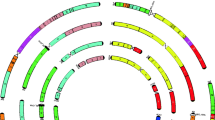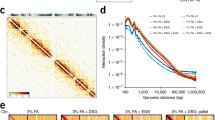Abstract
A software tool for straightening curved chromosomes has been developed and integrated into the freely available image analysis application Image SXM (available via the Internet at http://reg.ssci.liv.ac.uk). This new tool straightens curvilinear objects in one simple step after minimal input from the user. The ends of a curvilinear chromosome are identified by the user using the mouse and a window is opened displaying the object as it would appear if it was straightened out. This image processing produces linear images of chromosomes with no loss of resolution or spatial calibration, making subsequent analysis significantly more straightforward.
Similar content being viewed by others
References
Barrett SD (2002) Software for scanning microscopy. Proc Roy Microsc Soc 37: 7-14.
Bickmore W, Craig J (1997) Chromosome Bands: Patterns in the Genome. Heidelberg: Springer-Verlag, p 185.
Carothers A, Piper J (1994) Computer-aided classification of human-chromosomes — A review. Stat Comput 4: 161-71.
Carvalho CR, Saraiva LS (1997) High-resolution HKG-banding in maize mitotic chromosome. J Plant Res 110: 417-420.
Kocsis E (2000) http://rsb.info.nih.gov/ij/plugins/straighten. html, from an algorithm described in Kocsis E, Trus BL, Steer CJ, BisherME and Steven AC (1991) J Struct Biol 107: 6-14.
Kress H (1996) Polytene chromosome: A general model for the eucaryotic interphase state. Int J Insect Morphol Embriol 25: 63-91.
MacGregor HC (1988) Working with Animal Chromosomes. Chichester: John Wiley, p 289.
Rasband W( 1998) NIH Image is a public domain program developed at the U.S. National Institutes of Health and available on the Internet at http://rsb.info.nih.gov/ nih-image/
Rasband W( 2002) Image/J is a public domain program developed at the U.S. National Institutes of Health and available on the Internet at http://rsb.info.nih.gov/ij/
Seabright M (1971) A rapid banding technique for human chromosomes. Lancet 2: 971-972.
Spowart G (1994)Mitotic metaphase chromosome preparation fromperipheral blood for high-resolution. In:Gosden JR, ed. Chromosome Analysis Protocols. New Jersey: Humana Press, pp 1-10.
Sumner AT (1990) Chromosome Banding. London: Unwin Hyman, p 434.
Sybenga J (1992) Cytogenetics in Plant Breeding. Berlin: Springer-Verlag, p 460.
Teixeira E, Carvalho CR (2000) Chromomeric pattern of maize pachytene chromosome after trypsin treatment. Hereditas 133: 183-187.
Verma RS, Babu A (1995) Human Chromosomes: Principles and Techniques, 2nd Edn., New York: McGraw-Hill, p 419.
Author information
Authors and Affiliations
Rights and permissions
About this article
Cite this article
Barrett, S.D., de Carvalho, C.R. A software tool to straighten curved chromosome images. Chromosome Res 11, 83–88 (2003). https://doi.org/10.1023/A:1022066301266
Issue Date:
DOI: https://doi.org/10.1023/A:1022066301266




